How to Make Marketing Employee Performance Reviews and Evaluations Easy (Templates)
 No one enjoys doing employee performance reviews. They’re often slightly uncomfortable conversations, and even in a best-case scenario, everyone involved feels relieved when they’re done. That isn’t exactly a ringing endorsement for their value, necessity, or how we feel about them.
However, they are valuable, they are necessary, and when conducted with a thoughtful process, they can be something you approach with less anxiety. When you can repeat that process effectively with consistent results, you can spend less time planning for reviews, and more time working through them efficiently with the results you want.
In this post, you’ll learn:
No one enjoys doing employee performance reviews. They’re often slightly uncomfortable conversations, and even in a best-case scenario, everyone involved feels relieved when they’re done. That isn’t exactly a ringing endorsement for their value, necessity, or how we feel about them.
However, they are valuable, they are necessary, and when conducted with a thoughtful process, they can be something you approach with less anxiety. When you can repeat that process effectively with consistent results, you can spend less time planning for reviews, and more time working through them efficiently with the results you want.
In this post, you’ll learn:
- Why are performance reviews important for marketing managers and teams?
- What steps should they include and which questions should be asked?
- How can marketing teams develop a repeatable review process that works?
Be a Better Manager With Free Performance Review + Evaluation Form Templates.
Click To TweetBe a Better Manager With Free Performance Review + Evaluation Form Templates
Employee reviews don’t need to be overly complex. However, you will need to keep documentation of your conversation so you have something to reference in the future, to ensure the important details of the review aren’t forgotten later. You'll also need to accurately evaluate performance before going into each meeting. To get started, download these two templates:- Marketing Performance Evaluation Form (Word): Answer six simple questions to gauge performance.
- Marketing Employee Performance Review Template (Word): Then, use this sheet to document the meeting.
How Can CoSchedule Help Evaluate Team Productivity?
As a marketing project management platform, CoSchedule is purpose-built for managing busy marketing teams. That includes your tasks and workflows for all projects and making sure everyone is getting their stuff done on time. One way CoSchedule measures that last item is with Team Performance Reports. It measures who’s rocking it and who’s falling behind so you can actually know who’s hitting their deadlines. Here's a quick look at how it works: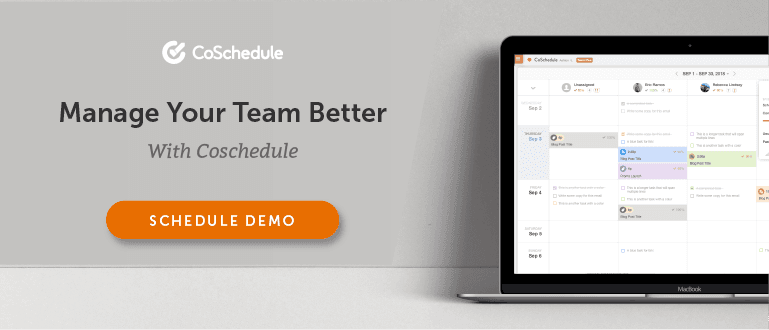
What Exactly is an Employee Performance Review?
Here’s a short definition this post will work with: An employee performance review is an opportunity for team members and managers to assess what’s going well, what isn’t going well, and what’s necessary for future success with a company or organization. There are a few things to note about this definition:- It shouldn’t feel like an interrogation. A good review shouldn’t focus solely on negatives.
- They aren’t one-and-done meetings. Feedback gathered in a review should be considered and implemented throughout the year.
- This should be a two-way conversation. They aren’t just about assessing the team member’s performance; they’re also an opportunity to get the employee’s take on how they’re doing and how the company is doing, too.
What Are the Benefits to Running Employee Reviews for Marketers?
First things first, it’s important to understand that these meetings are more than just an annual requirement that you have to fulfill to keep HR happy. Here are a few reasons why they shouldn’t be blown off or phoned in without careful consideration for their purpose.- Your team members need an honest assessment of their performance. If they don’t know how they’re doing (positively or negatively) or where they need to improve, they’re unlikely to reach their potential.
- You need to know what your team members need to succeed. Likewise, you can’t help your team achieve success unless you understand what they need from you.
- If you don’t set up employees for success, someone else will (when they leave your company). The market for marketing talent is tight. Don’t let people leave because they didn’t feel supported.
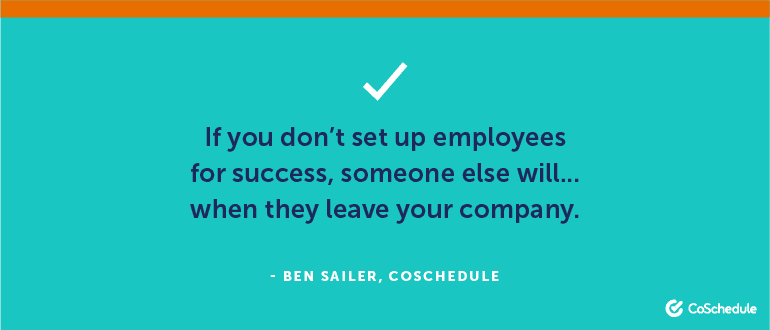
Help Your Team, Help Your Company (Before They Leave)
As a case in point, according to Smart Insights, 54.9% of marketers switch companies in order to find a new challenge. Why not provide that challenge for them instead of leaving them to find it somewhere else? And if that statistic doesn’t have you convinced, these might:
Who Should Be in an Employee Review Meeting?
In most cases, a marketing manager, their supervisor(s), and the employee themselves should be sufficient. If possible, including the CEO too is a good idea (at CoSchedule, CEO Garrett Moon offers direct feedback to each employee in the company during reviews). Then, once the review is completed, human resources will likely need to approve review paperwork (and any pay raises the team member might be due). Work with your HR department if you’re unsure what your internal processes are there.How Often Should Reviews Be Conducted?
Here’s a common misconception: staff reviews are a once-a-year deal where you get all your feedback out at once. This could not be more incorrect, but unfortunately, it’s a common attitude (particularly at large companies where one-on-one communication might be challenging to schedule, or just doesn’t happen organically). So, how often should feedback be scheduled? Consider the following:- Weekly syncs: Set up a recurring one-on-one meeting with each team member to check in on how things are going.
- Quarterly check-ins: Then, schedule quarterly meetings to review how things have gone year-to-date and what’s needed for success over the long term.
- Annual reviews: Finally, these are holistic performance evaluations that take the entire previous year into consideration.
 For marketers, ongoing mentorship with leadership is invaluable for development. Also, this post will stress this point multiple times: an annual review should not be the first time an employee hears a given piece of feedback.
This is a sign they don’t feel like they can be open and honest with how things are going outside of times allotted for feedback, and that’s corrosive for everyone’s productivity and happiness at work.
For marketers, ongoing mentorship with leadership is invaluable for development. Also, this post will stress this point multiple times: an annual review should not be the first time an employee hears a given piece of feedback.
This is a sign they don’t feel like they can be open and honest with how things are going outside of times allotted for feedback, and that’s corrosive for everyone’s productivity and happiness at work.
Scheduling Your Review Meetings
The best way to make sure your review meetings actually happen is to schedule them on a regular basis. Schedule the following using your company’s shared Google or Outlook calendar:- Weekly meetings: Stick to a set time each week.
- Quarterly reviews: Stick as closely to a 90-day window as you can.
- Annual reviews: Same as with quarterly reviews, they should be close to their start date each year.
Evaluating Employees Prior to Your Meetings
Before heading into a review, you’ll need to know for yourself what you honestly think about each employee’s performance, both in terms of what they’re doing well and where they can improve. It can help to have some sort of checklist to run through when assessing each team member, especially if you have a large team. In order to keep your meetings focused and conversational, do this before meeting face to face. Here’s an outline of a checklist you can use:- Does the team member demonstrate high level of job knowledge?
- Does the team member complete work accurately and on time?
- Does the team member work well with others?
- Does the team member communicate effectively?
- Does the team member demonstrate initiative?
- Does the team member consistent show up to work on time?
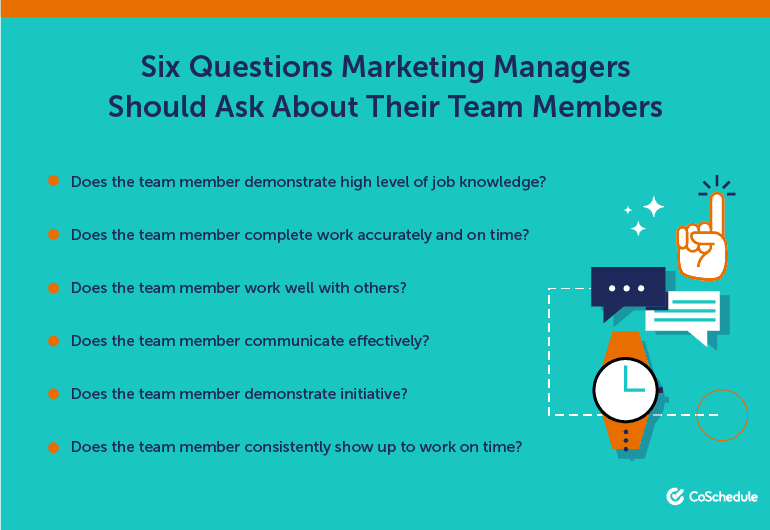 These are basic performance-oriented questions you’ll need to assess, and running through them as an exercise might help you identify strengths and areas in need of improvement. If you’d prefer this in a Word doc, there’s one included in this post’s template bundle. You can jump back up to the top of the post here to download it quick. Here's what it looks like:
These are basic performance-oriented questions you’ll need to assess, and running through them as an exercise might help you identify strengths and areas in need of improvement. If you’d prefer this in a Word doc, there’s one included in this post’s template bundle. You can jump back up to the top of the post here to download it quick. Here's what it looks like:
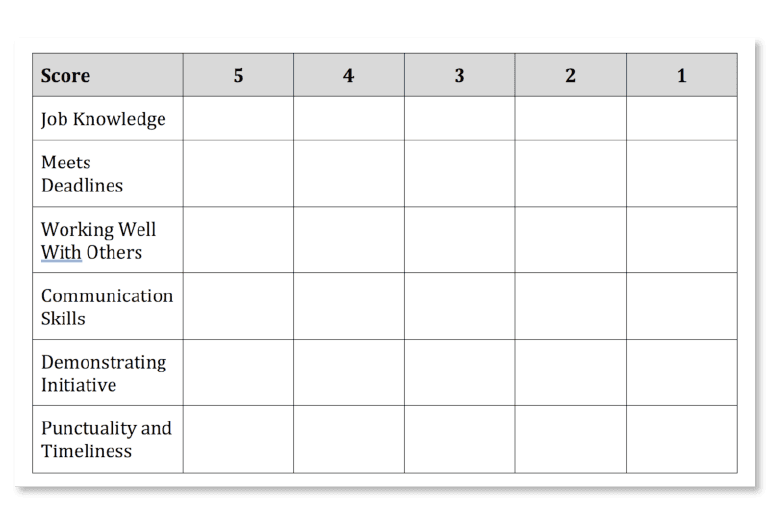
Planning Your Review Questions
Once you’re face-to-face for a review, what should you ask? It might be tempting to prepare a detailed list of questions to dig deep into the needs of your team members. That might work. After all, it stands to reason that more granular questions will get more detailed answers, right? Well, you might be able to have a more productive and insightful conversation by keeping your questions simple. There are only three you really need to ask:- What’s going well? This can be an open-ended discussion around what’s going right for the employee, their work, and the company.
- What isn’t going well? Same as above, but for things that need improvement.
- What’s needed for a successful future? What should the employee keep doing? What should they change? And likewise, is there anything you or the company may need to consider as well?
 Generally, it’s best to keep this an open-ended conversation. But, as that conversation moves forward, how do you make sure it stays on track and the words you choose to maintain a productive tone?
Generally, it’s best to keep this an open-ended conversation. But, as that conversation moves forward, how do you make sure it stays on track and the words you choose to maintain a productive tone?
The only three employee review questions #marketing managers need.
Click To TweetSome Examples of Phrases You Might Use in Each Review Phase
That’s where this next section comes in. While the discussion will sound awkward if it's overly scripted, there are ways to phrase things that best expresses the point you’re getting at. Here are some suggestions. For things that are going well:- What do you attribute that success to?
- Is there anything we can do to better support your success?
- How can we do even better at this?
- How would you suggest correcting this problem?
- Are there any lessons you’ve learned from failure this year?
- If you were to [INSERT MISTAKE] again, is there anything you’d change in your approach?
- What should we be doing that we aren’t right now?
- If there was anything you could change right now, what would it be?
- Where do you want your career to go in the next year? Three years? Five years?
How to Run Employee Review Meetings
Conducting the actual meeting (doing things the CoSchedule way) is a simple process. Once a time has been blocked off on your calendar, you just need to find a quiet place to meet. If you know you’ll need to book a room in your building in advance, consider doing this at the same time you add the meeting to your calendar. This way, you can avoid scrambling at the last minute. Then, consider grabbing your refreshment of choice (if you’re nervous for any reason, you might want to avoid caffeine). From there, keep the following tips in mind.Make Sure it’s a Two-Way Conversation
Imagine being dragged into a room to get grilled on every mistake you’ve made over the last 12 months. How do you think you’d respond to such a situation? Even the best of us would likely get defensive and ultimately wonder why none of the errors or slights mentioned were addressed sooner. Furthermore, that would be a one-sided conversation, centering around you and what you offer your company. As a manager, it’s important that you understand exactly what value someone is bringing to the table and making sure they’re carrying their weight. Marketing doesn’t deal in participation trophies; everyone has to be making a meaningful contribution toward raising revenue. But, you also need to understand what value you and your company offer your employee. In an industry where talented professionals can choose to take their skills elsewhere, they choose to work for you. So, treat the review like what it should be: a conversation between professionals.Stay Calm and Professional (Even if You Have to Offer Blunt Feedback)
As a manager, you set the tone for the conversation. Keep it professional and ensure negative feedback is measured and constructively framed. This is easier said than done, though the book Crucial Conversations is a worthwhile read if you need help in this area. The following video from Vital Smarts is a bit long at around half an hour, but it effectively summarizes what you need to know about the power and importance of being able to have tough talks:Don’t Wait Until an Annual Review to Address Severe Underperformance
This isn’t the first time it’s mentioned in this post. It certainly shouldn’t be the last time you repeat this mantra to yourself. But, here it is again: an annual review should not be the first time and place a team member hears about a problem. If someone isn’t cutting it, address the issue when it arises. And if it’s necessary, you might need to develop some sort of improvement plan, or maybe even let them go (though these are other topics entirely beyond the scope of this post, and we certainly hope you’ll do everything possible to help your team succeed before resorting to parting ways with anyone). Take care of issues when they become issues, not when they become catastrophes later. Which is exactly what the evaluation is going to turn into if you cut corners here.Document Comments and Important Discussion Points to Follow Up on Later
While you’re conducting the review, keep notes about what’s discussed. Record both the team member’s thoughts and your own. Use the employee review template included in this post (you can take a shortcut to find it here).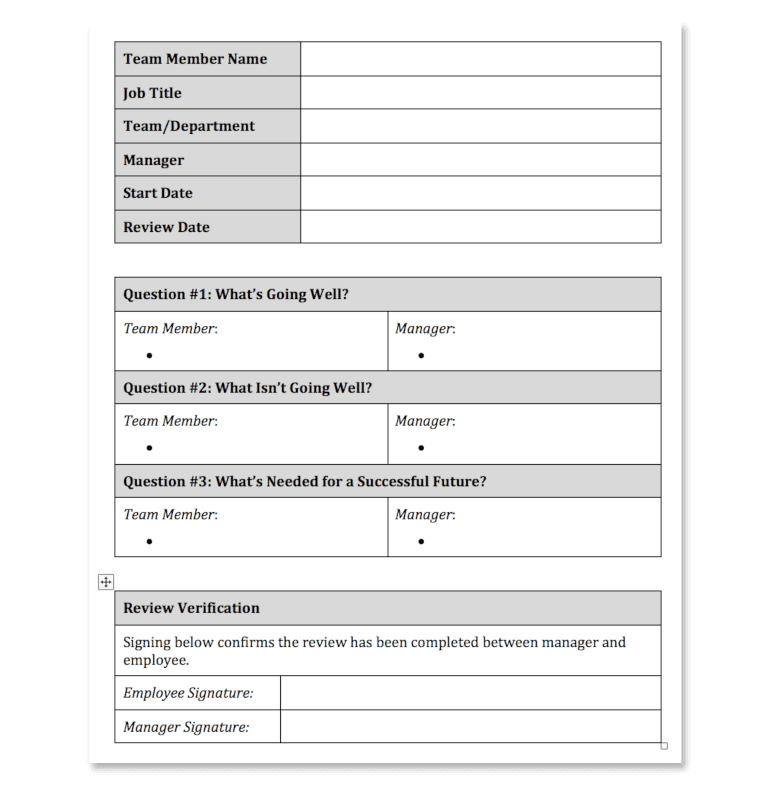
Measure Productivity With Team Performance Reports in CoSchedule
When evaluating the talent on your team and their actual productivity, it’s nice to have actual data to quantify how well everyone’s doing. That’s where Team Performance Reports in CoSchedule come in. Here’s how they work. Each time you create a project in CoSchedule, you can add Tasks (and even save lists of tasks in Task Templates): Each task can be assigned to a team member and given a due date. Every time a task is completed, it can be checked off and marked complete:
Each task can be assigned to a team member and given a due date. Every time a task is completed, it can be checked off and marked complete:
 Then, the Team Performance Report shows who’s getting their tasks completed on time, and who’s lagging behind. This makes it easy to know who’s hitting deadlines, and who might need some help. If you didn't catch it the first time around in this post, here's the video again:
Then, the Team Performance Report shows who’s getting their tasks completed on time, and who’s lagging behind. This makes it easy to know who’s hitting deadlines, and who might need some help. If you didn't catch it the first time around in this post, here's the video again:


